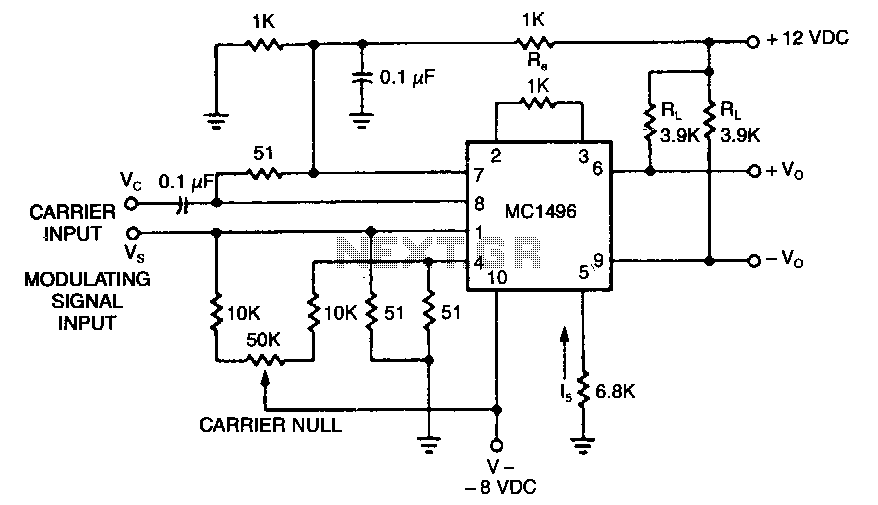
Double-sideband-suppressed-carrier-modulator

The basic current allows no carrier to be present in the output. By adding offsets to the carrier differential pairs, controlled amounts of carrier appear at the output. The amplitude becomes a function of the modulation signal - AM modulation.
In electronic circuits, the described current configuration is foundational in achieving modulation without the presence of a carrier signal at the output. The principle involves utilizing differential pairs, which are pairs of transistors or other active devices that operate in a complementary manner. By introducing offsets to these differential pairs, it is possible to manipulate the output to include a controlled carrier signal.
This process is particularly relevant in Amplitude Modulation (AM), where the amplitude of the carrier wave is varied in accordance with the information signal. The modulation signal, which represents the information to be transmitted, influences the amplitude of the output signal. The careful adjustment of offsets allows for precise control over the amount of carrier signal that is mixed with the modulation signal, ensuring that the desired output characteristics are achieved without introducing unwanted distortion or noise.
In practical applications, this technique is often implemented in RF (radio frequency) transmitters and receivers, where maintaining signal integrity is crucial. The design of such circuits typically involves careful selection of components to ensure linearity and minimize interference. Additionally, feedback mechanisms may be employed to stabilize the output and enhance performance across varying operating conditions. Understanding the interplay between the modulation signal and the carrier signal is essential for optimizing the overall system design and achieving high-quality transmission of information.The basic current allows no carrier to be present in the output. By adding offsets to the carrier differential pairs, controlled amounts of carrier appear at the output. The amplitude becomes a function of the modulation signal-AM modulation.
In electronic circuits, the described current configuration is foundational in achieving modulation without the presence of a carrier signal at the output. The principle involves utilizing differential pairs, which are pairs of transistors or other active devices that operate in a complementary manner. By introducing offsets to these differential pairs, it is possible to manipulate the output to include a controlled carrier signal.
This process is particularly relevant in Amplitude Modulation (AM), where the amplitude of the carrier wave is varied in accordance with the information signal. The modulation signal, which represents the information to be transmitted, influences the amplitude of the output signal. The careful adjustment of offsets allows for precise control over the amount of carrier signal that is mixed with the modulation signal, ensuring that the desired output characteristics are achieved without introducing unwanted distortion or noise.
In practical applications, this technique is often implemented in RF (radio frequency) transmitters and receivers, where maintaining signal integrity is crucial. The design of such circuits typically involves careful selection of components to ensure linearity and minimize interference. Additionally, feedback mechanisms may be employed to stabilize the output and enhance performance across varying operating conditions. Understanding the interplay between the modulation signal and the carrier signal is essential for optimizing the overall system design and achieving high-quality transmission of information.The basic current allows no carrier to be present in the output. By adding offsets to the carrier differential pairs, controlled amounts of carrier appear at the output. The amplitude becomes a function of the modulation signal-AM modulation.